K. Bhuvaneswari and R. Muthamizh Veena
Department of Pharmacology, PSG Institute of Medical Sciences and Research, Coimbatore,Tamil Nadu,India.
Corresponding Author E-mail: nandabhuvana@gmail.com
DOI : https://dx.doi.org/10.13005/bpj/1217
Abstract
Knowledge regarding use of medicine to school teachers is an important component of the overall health care delivery system of any country2. School teachers need to be aware of rational use of medicines because health education provided by them may have an immediate effect on students, their parents and also to the community. This study is aimed to evaluate the medication practices of school teachers in Coimbatore including the both city and rural areas. It wasaCross sectional study using a preformed questionnaire conducted from October 2014 to January 2015 among 400 School teachers working in both government and private schools in Coimbatore (city and rural areas) After getting approval from IHEC, then. Permissions from School management were obtained. Written informed consent from the participants and the Questionnaire was filled by them. Finally, the results were analyzed and the study was completed. Among the School teachers who voluntarily participated in this study, we found 86.5% follow doctor’s advice for their personal ailments. However, nearly 76% of teachers does not visit physician for basic complaints. About 44.5% give medications to children without doctor’s prescription / advice. Around 73% agree the importance of full course of medicines as per the prescription. This study revealed wide gap in the knowledge of health habits and medication practices, which can be overcome in future with personal / group discussion in the form of workshop to alleviate the doubts in their minds, since we understand that teachers are the best medium to disseminate the concept of rational use of medicines to the society.
Keywords
Knowledge; Medication practices; School teachers
Download this article as:| Copy the following to cite this article: Bhuvaneswari K, Veena R. M. Medication Practices of School Teachers in Coimbatore. Biomed Pharmacol J 2017;10(3). |
| Copy the following to cite this URL: Bhuvaneswari K, Veena R. M. Medication Practices of School Teachers in Coimbatore. Biomed Pharmacol J 2017;10(3). Available from: http://biomedpharmajournal.org/?p=15987 |
Introduction
Appropriate use of medicines plays an important role in clinical practice. Both the health professionals and the public need to be aware of the rational drug usage and the consequences of inappropriate or irrational use of medicines having ill effects on health. Almost half of all medicines are used irrationally all over the world according to WHO. Globally up to 80% of illness episodes are self-treated with modern pharmaceuticals.1 This can have severe outcomes like drug resistance, adverse drug reactions, prolonged illness and even death. Lack of access to medicines and high financial cost are some of the common reasons particularly found in developing countries like India.
Knowledge regarding use of medicine to school teachers is an important component of the overall health care delivery system of any country.2 School teachers need to be aware of rational use of medicines because health education provided by them may have an immediate effect on students, their parents and also to the community. This study is aimed to evaluate the medication practices of school teachers in Coimbatore including the both city and rural areas.
The World Health Organization has defined Rational Use of Drugs as follows: “Patients receive medicines appropriate to their clinical needs, in doses that meet their own individual requirements, for an adequate period of time, and at the lowest cost to them and the community”.3 Irrational use of medicines includes overtreatment of a mild illness, inadequate treatment of a serious illness, misuse of anti-infective drugs, over-use of injections, self-medication of prescription drugs and premature interruption of treatment.4
People have several reasons for irrational use of medicines like lack of knowledge or skills, unrestricted availability of medicines, overwork of health personnel, inappropriate promotion of medicines and profit motives from selling medicines. There are twelve core interventions by WHO to promote more rational use of medicines and public education is one among them. Without sufficient knowledge about the risks and benefits of using medicines and when and how to use them,
People will often not get the expected clinical outcomes and may suffer adverse effects. This is true for prescribed medicines, as well as medicines used without the advice of health professionals.3
Children spend a considerable part of their life in school exposed to a variety of environmental, physical, emotional and social influences. School is the place where the child learns how to interact, behave with others and to give and accept respect and the school teachers are the one who are creative, caring, dedicated, determined and have the ability to shape up the students to shine as a responsible person in the community. As teachers play an important role in educating their students and are regarded as learned and respected persons in local communities it is important that they have proper knowledge about medicines.5,6 This knowledge can be transferred to their students, their parents and members of the community.
A study done in Kuwait among school children found that self-medication among adolescents shown to be high and teachers considered teaching their students about the proper use of medicines so important that it should be included in the national curriculum of health education.7 Similarly, another study done in Poland illustrated that appropriate informational devices implemented in primary and secondary schools could play an influential role in reducing the strain of community-acquired infections. The resource improves knowledge about microorganisms, hygiene and antimicrobial agents, and can be targeted at pupils, teachers and parents.8 A pre-post comparison of a community intervention in Nepal has also shown the seriousness and gain of educating school teachers and their impact on students.9 Another questionnaire based study done before and after the educational intervention in Nepal regarding the knowledge, attitude and practice towards medicines among school teachers showed overall improvement in total scores post-intervention.10 Similarly a study done among literate consumers in Dehradun found the habitual stocking of medicines, awareness regarding the expiry period of medicines and their self-perception in usage of medicines in addition to the doctor’s advice.11
In developing countries like India where the morbidity and mortality rates are high, awareness on rational medication usage is necessary to the society. At schools students are taught different subjects including topics like human body, health and nutrition, environmental health and personal hygiene. Teachers who teach the students should have at least a basic knowledge in using medicines which can be transferred to students and through them to parents and the community.
Coimbatore is the second largest city in Tamil Nadu state in India which is surrounded by the Western Ghats and known for its pleasant climate. It is credited as the “Manchester of SouthIndia” due to its cotton production and textile industries. Coimbatore has a population of 1,601,438 with an average literacy rate of82.43%.12 Though the city is known for its traditions; heavy industrialization has resulted in the growth of trade unions. There are various ethnic groups settled here as a result of increased economic growth and job opportunities. So this study is planned to evaluate the medication practices of school teachers in the city and rural areas of Coimbatore.
AIM And Objective
To evaluate the medication practices of school teachers in the city and rural areas of Coimbatore.
Methodology
Study design: Cross sectional study using a preformed questionnaire
Study period: October 2014 to January 2015
Study population: School teachers working in both government and private schools in Coimbatore
Study area: Coimbatore (city and rural areas)
Sample size: 400
Methodology
After getting approval from IHEC, then. Permissions from School management were obtained. Written informed consent from the participants and the Questionnaire was filled by them. Finally, the results were analyzed in percentage (frequencydistribution)and the study was completed.
Results
Among the School teachers who voluntarily participated in this study, we found 86.5% follow doctor’s advice for their personal ailments. However, nearly 76% of teachers does not visit physician for basic complaints. About 44.5% give medications to children without doctor’s prescription / advice. Around 73% agree the importance of full course of medicines as per the prescription. (Table 1)
Discussion
This cross sectional study using a preformed questionnaire was done to evaluate the medication practices of school teachers in the city and rural areas of Coimbatore district. Over 400 school teachers working in both government and private schools including primary, middle and higher secondary schools in Coimbatore district after obtaining permission through proper channel from the school management participated in the study. The teachers were given a brief explanation about the study and after obtaining informed consent they were asked to fill up the questionnaire.
In this study only 22% from city, 27% from rural areas visit doctor for basic complaints (Table.1) and most of them (93%) consider that it is not necessary to visit doctor for simple / basic complaints (Fig.1).
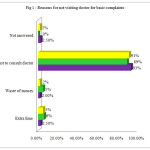 |
Figure 1: Reasons for not visiting doctor for basic complaints |
Around 81% from city and 89% from rural areas said that they won’t purchase medicines without doctor’s prescription (Table.1). About half of the study population said that they purchase medicines without prescription for minor or simple complaints. Others have mentioned that it takes lot of time to consult a doctor and in order to save time they purchase by themselves (Fig.2).
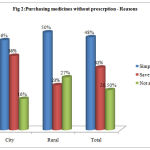 |
Figure 2: Purchasing medicines without prescrption – Reasons |
Most of the school teachers from both city (88.50%) and rural (84.50%) areas have said that they follow the instructions given by the doctors / pharmacists to use drugs appropriately [eg. taking antacids in empty stomach] (Table.1).
In this study around 71% of school teachers from city and 74.50% of school teachers from rural area (Table.1) purchase full course of medicines as per prescription given by the doctor. Remaining teachers have answered that based on improvement of symptoms further purchase could be done (around 50%), some teachers answered that medicines need not be taken for a long time and others said that too many medicines would spoil their health (Fig.3).
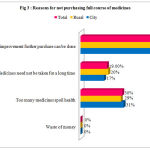 |
Figure 3: Reasons for not purchasing full course of medicines |
Among the 400 school teachers, around 96% (97.50% from city and 94.50% from rural areas) have answered that they would check the expiry date before intake of medicine (Table.1).
Most of the teachers participated in the study answered that they would not give adult medications to children (Table.1). The most common reason was that it is not safe to give adult medicines to children (70% in city % 62% in rural area) followed by dosages cannot be adjusted for children and medicines given for adult won’t work for children (Fig.5). Very few teachers answered that they give adult medications to children because there is no difference between adult and children medicines and quicker recovery occurs due to high dose as given for adults (Fig.4).
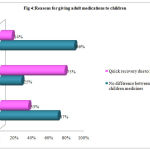 |
Figure 4: Reasons for giving adult medications to children |
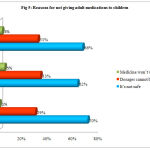 |
Figure 5: Reasons for not giving adult medications to children |
Around 35% from city and 26% from the rural areas have answered that they use the same prescription again and again for getting the drugs from pharmacy without consulting a doctor (Table.1).
Table 1: Knowledge of school teachers in percentage for the given questionnaire
| S.No | Questions | City (%) | Rural (%) | Total (%) | |||
| Yes | No | Yes | No | Yes | No | ||
| 1 | Do you visit doctor for a basic complaint (eg. headache)? | 22 | 78 | 27 | 73 | 24 | 76 |
| 2 | Do you purchase medicines from pharmacy without a doctor’s prescription? | 19 | 81 | 11 | 89 | 15 | 85 |
| 3 | Do you follow the instructions given by the doctors / pharmacists to use drugs appropriately (eg. antacids in empty stomach)? | 88.5 | 11.5 | 84.5 | 15.5 | 86.5 | 13.5 |
| 4 | Would you agree purchasing full course of medicines as a must as per the prescription? | 71 | 29 | 74.5 | 25.5 | 73 | 27 |
| 5 | Do you have the habit of checking expiry date before intake of medicine? | 97.5 | 2.5 | 94.5 | 5.5 | 96 | 4 |
| 6 | Do you give adult medications to children? | 6 | 94 | 2 | 98 | 4 | 96 |
| 7 | Do you use the same prescription given by the doctor for a particular health complaint once again without consulting him? | 35 | 65 | 26 | 74 | 31 | 69 |
| 8 | Do you have the habit of using your family member’s medications for your health complaints? | 10.5 | 89.5 | 13.5 | 86.5 | 12 | 88 |
| 9 | Are you regularly maintaining first aid box in school? | 93.5 | 6.5 | 97 | 3 | 95 | 5 |
| 10 | Do you have the habit of giving medications to children without doctor’s prescription/advice? (Eg. fever- paracetamol, pain-brufen, cough-cough syrup, diarrhea-Electral powder) | 48 | 52 | 41 | 59 | 44.5 | 55.5 |
| 11 | Have you shared fellow staff member/family members with your medicines? | 19.5 | 80.5 | 16.5 | 83.5 | 18 | 32 |
| 12 | Do you have the habit of stocking medications at home to use in case of emergency? | 66 | 34 | 64.5 | 35.5 | 65 | 35 |
Only 10.50% from the city and 13.50% from rural areas use their family members medications for their health complaints (Table.1).The reasons they have mentioned for using their medicines were that they use only for simple complaints or they have similar complaints as them. Most of them did not use their family members’ medicines as they considered them to be not safe or they have different health complaints not related to them.
Regarding the maintenance of first aid box in the schools, around 93.50% from the city and 97% from the rural areas have answered that they regularly maintain the first aid box in their schools (Table.1).
In this study it was found that almost half of the school teachers (48% from city and 41% from rural) give medications to children without doctor’s advice or prescription (Table.1).
Regarding sharing of their medicines with the staffs or family members, only about 19.50% from city and 16.50% from rural areas share their medicines with others (Table.1). They mainly used to share medicines for fever, pain, acidity, diarrhea and respiratory infections (Fig .6).
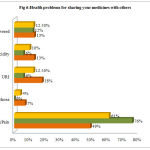 |
Figure 6: Health problems for sharing your medicines with others |
In this study it was found that around 66% from city and 64.50% from rural areas were stocking medications at home (Table.1).Only some of the teachers have mentioned the drugs that they stock at home. They used to stock analgesics, cough syrups, antacids and anti diarrheal medications.
Conclusion
From the above results it was found three fourth of school teachers practice self-medication for basic complaints and one third teachers share their medicines with family members. Nearly half of participants administer medicines to their children without a prescription
This study revealed wide gap in the knowledge of health habits and medication practices, which can be overcome in future with personal / group discussion in the form of workshop to alleviate the doubts in their minds, since we understand that teachers are the best medium to disseminate the concept of rational use of medicines to the society.
References
- Fresle D. A and Wolfheim C. Public education in rational drug use: a global survey. Action Programme on Essential Drugs. World Health Organization. 1997.
- Hameen-Anttila K., Juvonen M., Ahonen R., et al. What Schoolchildren should Be Taught about Medicines: Combined Opinions of Children and Teachers? Health Education. 2005;105(6):424-436.
CrossRef - World Health Organization. Promoting rational use of medicines: core components.
- World Health Organization Media Centre: Promoting rational use of Medicines save lives and money, WHO experts say. http://www.who.int/mediacentre/news/notes/2004/np9/en/.
- Bozoni K., Kalmanti M., Koukouli S. Perception and knowledge of medicines of primary schoolchildren: the influence of age and socioeconomic status. European journal of pediatrics. 2006;165(1):42-49.
CrossRef - Ofovwe G. E and Ofili A. N. Knowledge, attitude and practice of school health programme among head teachers of primary schools in Egor Local Government Area of Edo State, Nigeria. Annals of African medicine. 2007;6(3):99.
CrossRef - Abahussain E. A., Matowe L. K., Nicholls P. J. Self-reported medication use among adolescents in Kuwait. Medical principles and practice. 2005;14(3):161-164.
CrossRef - Olczak-Pienkowska A and Grzesiowski P. Progress towards implementing the e-Bug Project in Poland. Journal of Antimicrobial Chemotherapy. 2011;66:77-79.
CrossRef - Kafle K. K., Karkee S. B., Shrestha N., et al. Community intervention to improve knowledge and practices on commonly used drugs. Kathmandu University Medical Journal. 2010;8(1):29-34.
CrossRef - Jha N., Bajracharya O and Shankar P. R. Knowledge attitude and practice towards medicines among school teachers in Lalitpur district, Nepal before and after an educational intervention. BMC public health. 2013;13(1):1.
CrossRef - Thawani V. R., Gharpure K. J and Sontakke S. D. Impact of medicine-related information on medicine purchase and use by literate consumers. Indian journal of pharmacology. 2014;46(4):420.
CrossRef - Coimbatore, https://en.wikipedia.org/w/index.php?title=Coimbatore&oldid=743263747







